Dog × Chicken
Mammalian Hybrids
|
For he who is acquainted with the paths of nature, will more readily observe her deviations; and vice versa, he who has learnt her deviations, will be able more accurately to describe her paths.
—Francis Bacon, Novum Organum
|
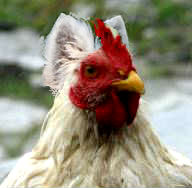 A reconstruction of the Scottdale bird as reported in the news story quoted below.
A reconstruction of the Scottdale bird as reported in the news story quoted below.
Claims that hybrids can be produced from this highly disparate cross require confirmation from a specimen.
Over the years there have been quite a few accounts published describing creatures that, if accurately reported, would seem to be dog-chicken hybrids. Several of these reports are quoted verbatim on this page.
A chicken with dog ears
A notice about the first of these two bizarre wonder hens, reconstructed in the picture at right, appeared in The West Virginian (Apr. 5, 1915, p. 8, col. 2), a newspaper published in Fairmont, West Virginia:
Freak Chicken Born With Terrier’s Ears
Another report, with additional information, appeared in The Washington Herald (Apr. 26, 1915, p. 1, col. 2), a newspaper published in Washington, D.C.:
HEN HAS DOG’S EARS
Hundreds Flock to Pennsylvania
Farm to See Freak.
Scottdale,‡ Pa., April 25.—The curiosity of residents for miles around has been aroused by the discovery of a hen with ears which stand erect like those of a dog, on the farm of John Bowser, near here, and hundreds of persons are visiting the farm to get a glimpse of it.
The ears are about three-quarters of an inch [~19mm] long and are growing from each side of the chicken’s comb.
Another report, in a New York newspaper, stated that “The hen is otherwise normal and an excellent layer.”
No normal bird has external ears, structures that biologists call “pinnae,” but dogs and most other mammals do. So the question then arises: Could the anomalous creature reported in these 1915 news stories have been a dog-chicken hybrid? If not, then one would have to suppose that some simple mutation in a chicken could somehow produce, de novo, such a complex structure as a terrier’s ear (or else that the reports were simply a hoax).
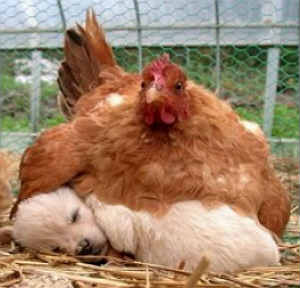
As to the feasibility of the requisite mating, various YouTube videos document the fact that small dogs have been occasionally known to mate with hens. Further, it is well known that chickens will adopt the young of other types of animals, including dogs, as shown in the picture at right. (Screenshots of news stories about hens who adopted puppies appear below on this page.)
A chicken with a dog’s tail
A separate event was also reported later that same year. One notice about the event appeared in The Sunday Telegram (Jun. 20, 1915, p. 6, col. 6), a newspaper published in Clarksburg, West Virginia:
Freakish
Chicken with a Dog Tail Hatched in New Jersey
The freak chicken [is] equipped with the usual head and body, but has four legs and a curly tail, similar to that of a French poodle. Its color is deep black.
Lautenbach says that as soon as the freak shows a disposition to chase cats or bark at the moon he will have it tied up in a dog house or else sent to a sausage factory.
A longer story about the same hatchling appeared in The Elizabeth Daily Journal (Jun. 16, 1915, p. 15, col. 7), a newspaper published in Elizabeth, New Jersey, the city where the event supposedly occurred:
Dog-tailed Chicken
Elizabeth Has New Freak of Interest to Science
The latest wonder, the dog-tailed chicken, the only original ring-tailed roarer, is the product of the chicken yard of John Lautenbach, of 520 Spring Street. It arrived in this world to-day in company with a number of chickens of the usual type, and rumor has it that when its mother hen caught sight of it she immediately went out of her mind.
However that may be, the “Ring-tailed Roarer” is apparently as healthy as any of its relatives, and eats chicken or soup meat with complete impartiality. It is equipped with the usual head and body of a chicken, but has four legs and a curly tail much of the nature of a French poodle’s. It is a deep black in color, and its feathers are something of a mixture, and contain a generous sprinkling of hair.
As far as is known, the egg from which the dog-tailed chick emerged was not unlike any of the others.
The new chick will be allowed to roam about at large with its fellows as long as it continues to be a chicken, but Mr. Lautenbach is determined that as soon as it shows a disposition to chase cats or bay at the moon he will have it tied up in the doghouse, or sent to the sausage factory.
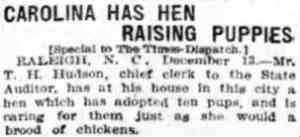 Above: A notice about a hen in North Carolina adopting ten puppies. From The Times Dispatch (Dec. 14, 1906, p. 1), a newspaper published in Richmond, Virginia.
Above: A notice about a hen in North Carolina adopting ten puppies. From The Times Dispatch (Dec. 14, 1906, p. 1), a newspaper published in Richmond, Virginia.
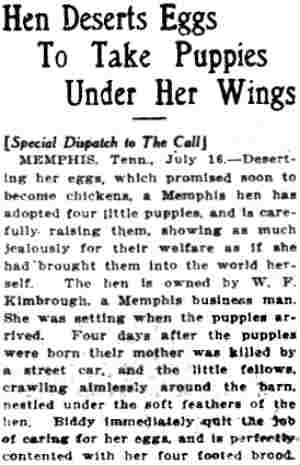 Above: A news story about a hen voluntarily adopting four puppies. From the San Francisco Call (Jul. 17, 1912, p. 1).
Above: A news story about a hen voluntarily adopting four puppies. From the San Francisco Call (Jul. 17, 1912, p. 1).
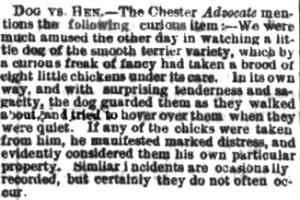 Above: A news story about a terrier voluntarily adopting eight chicks. From the Wilmington Daily Gazette (Aug. 16, 1873, p. 4), a newspaper published in Wilmington, Delaware.
Above: A news story about a terrier voluntarily adopting eight chicks. From the Wilmington Daily Gazette (Aug. 16, 1873, p. 4), a newspaper published in Wilmington, Delaware.
Incidentally, the Winsted, Connecticut freak referred to in the story just quoted was merely a case of a dog lying on a nest of chicken eggs and hatching them out, and no hybrid was alleged (four other examples of the same phenomenon: Example 1, Example 2, Example 3, Example 4).
However, the willingness of a dog to incubate chicken eggs is relevant to the present context given that such behavior can lead to aberrant imprinting. Dogs and chickens have also been known to befriend each other and work together to care for nests of eggs (Example 1, Example 2, Example 3), which might also easily have a effect on imprinting.
Chickens with dog’s heads
In 1870, the Illinois Statesman, a newspaper published in Bloomington, Illinois printed a notice about a museum exhibiting a chicken with a dog’s head (source). And in an earlier report, which may or may not refer to the same specimen, Recueil des actes de la séance publique de l’Académie impériale (1841, p. 39), a French language journal published by the Russian Imperial Academy of Sciences, reported that Karl Eduard Miram (1811-1887) gave a presentation before the Academy entitled A Description of a Monstrous Hen with a Face like a Dog’s (Beschreibung eines monströsen Huhnes mit hundeähnlichem Gesichte) (source). The actual text (in translation) of the notice reads “Mr. Miram, prosector at the Lithuanian Medical and Surgical Academy at Vilna gave us an anatomical description, accompanied by drawings, of a monstrous chicken with a canine face, which recalled the abnormality described by Fischer von Waldheim at Moscow some 20 years ago.” Miram was a professor of physiology and anatomy.
These last-mentioned reports, about chickens with dog heads, parallel another report, about a chicken with the head of a rabbit, and another about a mouse with the head of a chicken. These reports refer to animals found on farms, much like the alleged dog-chickens described above.
(Article continues below)
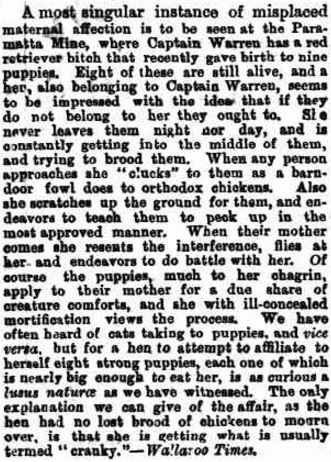 Above: A report that appeared in the South Australian Chronicle and Weekly Mail (Dec. 21, 1872, p. 7, col. 6), a newspaper published in Adelaide, South Australia.
Above: A report that appeared in the South Australian Chronicle and Weekly Mail (Dec. 21, 1872, p. 7, col. 6), a newspaper published in Adelaide, South Australia.
Making sense of these reports |
A dog and a chicken are very different kinds of animals, so different that many would say the production of a genuine dog-chicken hybrid would be impossible. However, similar hybrids have been reported, such as the dog-turkey hybrid pictured at right). Another, but rather more shocking chicken-mammal cross that has in fact been reported—and for which a specimen is available (see photo at right below)—is chicken x human. In this latter case there are many separate reports on record, for example, a live chicken with a human face on display at the Moscow Museum of Natural History.
And hybrids are always produced between different kinds of animals. The only question in the present case is how different the parents can be in a hybrid cross if they are to actually produce offspring. A certain amount of light is shed on this issue by the fact that commercial breeders have been able to produce hybrids between very different kinds of birds, for example, turkey and chicken, or quail and chicken. But the rate at which mature viable hybrids are produced in such crosses is quite low. In the turkey-chicken cross just mentioned, Olsen (1962) reports that it is necessary, on average, to carry out some 1,000 artificial inseminations to produce a single adult hybrid (see the picture of a turkey-chicken hybrid below).
So perhaps the same is true for dogs and chickens? Perhaps such weird crosses, ones between a mammal and a bird, require even more inseminations to produce a single viable hybrid? 10,000? 100,000? Who knows?
| A turkey-chicken hybrid: |
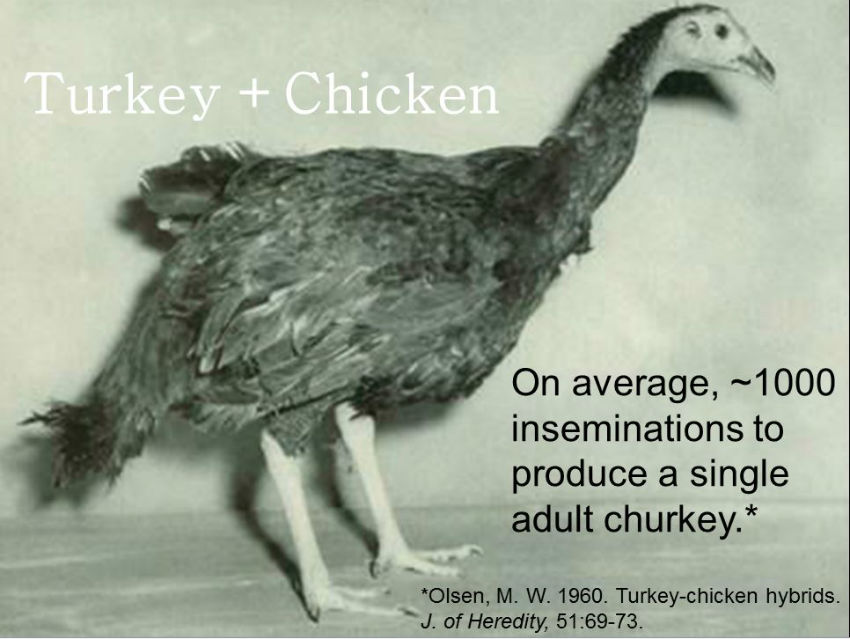
Chicken adopts puppies: |
Pitbull terrier befriends chicks: |
Most shared on Macroevolution.net:
Human Origins: Are we hybrids?
On the Origins of New Forms of Life
Mammalian Hybrids
Cat-rabbit Hybrids: Fact or fiction?
Famous Biologists
Dog-cow Hybrids
Georges Cuvier: A Biography
Prothero: A Rebuttal
Branches of Biology
Dog-fox Hybrids
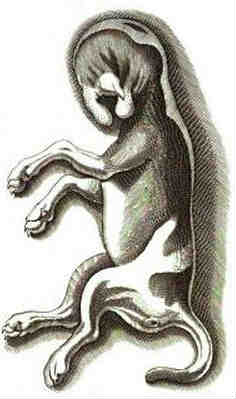 A dog-turkey hybrid >>
A dog-turkey hybrid >>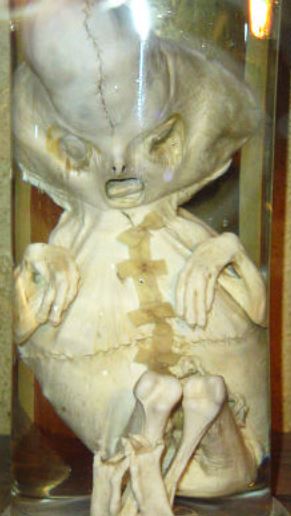 Chicken-human hybrids >>
Chicken-human hybrids >>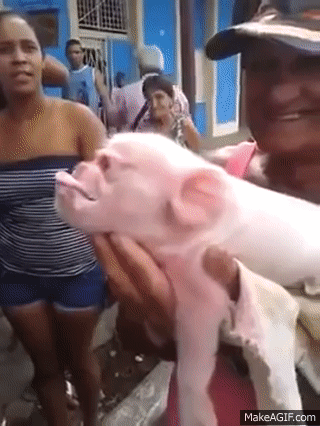 Pig-human hybrids >>
Pig-human hybrids >>